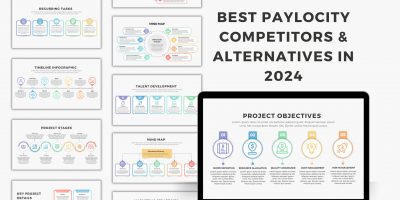
Decoding AI Regulation: What Employers Need to Know in 2025
Are you ready to navigate the uncharted waters of AI regulation in 2025, where innovation races ahead, but the rules are still being written?

Decoding workplace morale involves exploring the complex connections between how employees feel and how they act within a company.
Engagement plays a dual role in this, operating as both a contributor to and an outcome of employee morale, influencing well-being, job satisfaction, retention, and organizational success.
Beyond a mere corporate buzzword for end-of-year goals, employee engagement turns workers who only show up to clock in their hours into ones who problem-solve, are enthusiastic, and proactive.
As we explore all the nuances, we’ve compiled a list of 30 employee engagement statistics that give employers insight, direction, and actionable strategies.
Employee engagement represents workers’ commitment to a company, their performance, whether and how much they contribute to business growth, the level of active participation in their roles, or their emotional connection to their jobs.
An engaged employee means better performance, commitment, and growth. Conversely, low engagement could lead to some very unfavorable outcomes.
The following employee engagement statistics give a better overview of its importance, areas for improvement, and potential solutions for employers.
According to Gallup, global engagement is at a historic high post-pandemic, at 23%, in 2023. Although this is a somewhat optimistic scenario, it remains troubling that over three-quarters of the population still feels disconnected at work.
To address this issue and identify specific areas for improvement, organizations can analyze these employee engagement statistics through the lens of employee type:
On a more positive note, regional statistics show that the United States and Canada exhibit higher numbers, with 33% of their workforce engaged in 2023. However, this figure declined in the first quarter of 2024, and as of August 2024, it stands at 31%, still above the global average.
Despite the upward momentum post-pandemic, a significant portion of the population remains actively disengaged. In fact, in 2023, this was the case for 15% of employees globally. The average for the U.S. and Canada regions was 16%, while non-engaged employees comprise 51% of their workforce.
Looking at the trends from a generational perspective, baby boomers maintain the highest engagement at 36%. They are the only generation of workers with an increase in this metric, going from 34% to 36% since March 2020.
Moreover, the number of actively disengaged baby boomers in the workplace decreased from 17% to 15%.
Source: Gallup: The New Challenge of Engaging Younger Workers

On the other hand, engagement among Gen X employees fell from 35% to 31%, with the number of actively disengaged workers increasing from 17% to 18%.
Older Millennials’ productivity dropped from 39% to 32%, while their active disengagement increased from 12% to 17%.
Younger Millennials and Gen Z went from 40% in 2020 to 35% in 2023. Although their active disengagement was the lowest of all groups, it increased from 13% to 14% in the past few years.
Source: Gallup: The New Challenge of Engaging Younger Workers
Annual employee engagement for best-practice organizations stands at 70%, much higher than the global or regional rates. These are employers recognized as Gallup Exceptional Workplace Award winners or those who commit to investing in their employees to drive organizational change.
Such a large percentage is a testament to good workplace practices. In other words, employers can enjoy better engagement when workers are cared for. At the same time, this could lead to positive outcomes on many fronts, including the costly impact this has on the economy.
In its latest State of the Global Workplace report, Gallup estimates low employee engagement costs the economy trillions of dollars.
The report shows that much of the global workforce still struggles at work and in life, directly impacting organizational performance. It uses three parameters to measure the extent, including employee mental health, the role of the economy and policies, and the role of managers.
A Forbes overview of the cost for employers reveals that disengaged employees exhibit:
In financial terms, this results in an estimated loss of 34% of a disengaged employee’s annual salary, or about $3,400 for every $10,000 they earn.
The economic impact extends beyond immediate losses for employers, affecting team dynamics and long-term growth potential. Hence, investing in strategies to foster engagement can help employees explore their potential in and outside the workplace.
Higher levels of employee engagement are associated with improved morale outcomes, including well-being, health perceptions, and work-related attitudes.
Research shows that engaged employees report greater life and job satisfaction, lower levels of stress and burnout, and better organizational commitment, suggesting a strong correlation between the two.
Source: Evaluating Evidence on Employee Engagement and Its Potential Benefits to NHS Staff
Further findings corroborate the previous employee engagement statistic, demonstrating its impact on overall life experiences.
Notably, around half of engaged employees thrive in their personal lives, underscoring the link between workplace engagement and well-being.
Conversely, countries with favorable job markets tend to have lower rates of active disengagement, as employees feel empowered to leave unsatisfactory work situations.
Labor rights laws also play a role, with specific regulations correlating to better overall life satisfaction among workers. Notably, in countries where labor laws focus on fair wages, safe working conditions, and family responsibilities, engaged employees report the lowest stress levels, emphasizing the impact of supportive workplace policies.
When managers are engaged, employees, too, are more likely to be engaged.
While economic prosperity and labor protections may improve workplace morale, employee engagement is also strongly linked to manager relationships.
In this context, managers have the opportunity—and responsibility—to inspire their teams through goal setting, meaningful feedback, and accountability, fostering ongoing relationships built on respect and positivity.
Although managers take on a massive responsibility regarding engagement, they may not know how to respond to this.
According to Gartner, Chief Human Resources Officers (CHROs) agree that managers are responsible for most actions that lead to employee engagement. Unfortunately, only 19% of CHROs believe these managers can respond effectively.
Managers’ inability to respond effectively to engagement challenges may result from lacking tools and data. Approximately 40% report that they do not have access to the information needed to enhance engagement and drive results.
Addressing this gap requires HR support. They can equip managers with the right employee engagement resources and tools, help them better understand engagement data, and collaborate to develop actionable strategies.
Source: Harvard Business Review Analytic Services Research: A Winning Approach to Employee Success
Gallup has found that reducing disengagement leads to positive organizational outcomes. Their 2024 meta-analysis of over 183,000 business units across 53 industries and 90 countries showed that high-engagement teams experience significantly greater employee well-being, productivity, profitability, and sales than low-engagement teams.
A study by People Element shows that besides the high cost of disengagement, there are other negative implications, especially in the workplace. Namely, teams with low engagement are 43% likelier to endure high turnover rates than those with high engagement.
On the other hand, “healthy” organizations see improvements in many areas, from better retention to higher financial gains.

A “healthy” organization ensures that every employee feels heard and supported by promoting physical and mental wellness, maintaining a safe workplace, fostering financial equity, and cultivating a positive culture.
Employee engagement statistics show that these organizations are over three times more likely to engage and retain their workforce.
They also reduce absenteeism by 10.8 times, adapt to change 2.8 times more effectively, and exceed financial targets by 2.2 times.
People Element identifies three key drivers of employee engagement while recognizing that there is no one-size-fits-all solution:
These elements facilitate a supportive environment that enhances engagement and workplace morale.
Leadership style, managerial practices, company culture, job design, communication channels, and employee recognition programs all mediate engagement and organizational success.
Research also indicates that sustained efforts to strengthen these areas can lead to significant and lasting improvements in organizational performance, underscoring the necessity for ongoing investment in tailored human resource practices.
Source: Employee Engagement And Organizational Performance: A Human Resource Perspective
In addition to employee recognition programs, incentives also increase employee interest or engagement.
In fact, when companies introduce the right employee incentive programs for task completion, performance increases by 15%. Additionally, when they motivate the workforce to persist toward a goal, their performance can rise by 27%.
Incentives that encourage “thinking smarter” can also lead to a 26% increase in performance.
Source: Incentives, Motivation and Workplace Performance: Research and Best Practices
Research suggests that employee engagement enhances well-being, consequently improving other organizational aspects.
When employees feel a strong connection to their work and are actively involved in their tasks, they tend to have higher job satisfaction and emotional fulfillment. As a result, these employees are more likely to take fewer sick days and are typically less stressed.
Source: Employee Engagement And Organizational Performance: A Human Resource Perspective
Employees who felt burnt out, a trend especially prevalent among Gen Z and Millennials, were 30% less engaged, 36% more likely to report lower morale, 27% more prone to mistakes, and 25% more likely to leave the company or miscommunicate.
Source: Anatomy Of Work Special Report: Keeping Employees Engaged in a Burned-Out World
Conversely, engaged employees tend to experience lower levels of stress.
In fact, only 30% of engaged workers reported feeling high stress, while a significantly higher 58% of disengaged workers reported the same.
This stark contrast highlights the importance of fostering strategies for improving employee engagement. By creating a more supportive and motivating work environment, organizations can help reduce stress and burnout, leading to a healthier and more productive workforce.
While engaged employees typically achieve better results, those who aren’t thriving in their personal lives can pose risks to the organization. When comparing engaged employees who are thriving with those who are not, the differences are significant:
This connection goes both ways – career well-being is vital for personal well-being. So, when employees lack a fulfilling job and access to supportive resources, they may struggle to prosper.
One effective solution is prioritizing well-being initiatives, like wellness programs or flexible work arrangements, to encourage a positive cycle that enhances employee satisfaction and drives improved business outcomes.
Source: Employee Well-being Is Key for Workplace Productivity
Hybrid and remote employees demonstrate higher engagement levels compared to their on-site counterparts.
Specifically, 81% of hybrid and 78% of remote employees report high engagement, while 72% of in-office employees do. This data suggests that flexible work arrangements could lead to improvements for companies dealing with low employee engagement.
Leaders recognize the positive impact of employee engagement on their organizations, with 56% reporting that their investment in engagement initiatives has resulted in favorable ROI. This approach underscores the growing understanding that engaged employees contribute to workplace satisfaction and overall business success.
Source: Harvard Business Review Analytic Services Research: A Winning Approach to Employee Success
Another 81% of business executives agreed that highly engaged employees perform better and are more productive than those with average or low engagement.
The strong consensus among leaders further shows the value of employee engagement for organizations. These workers are more motivated, committed and take greater responsibility for their jobs, leading to higher-quality output and innovation.
Source: Harvard Business Review Analytic Services Research: A Winning Approach to Employee Success

Happy employees make for happy customers. The numbers only confirm this, as 72% of executives strongly agreed that organizations with highly engaged employees have satisfied customers. Workers provide better service and support when engaged, directly impacting customer satisfaction.
Source: Harvard Business Review Analytic Services Research: A Winning Approach to Employee Success
Despite the high awareness and a growing understanding of the value, only 37% of respondents strongly agreed that employee engagement is a significant area of focus for their organization.
While many executives acknowledge that engaged employees drive better performance and customer satisfaction, lacking targeted initiatives and resources may hinder progress. This reluctance could emanate from competing priorities, insufficient leadership commitment, or unclear metrics for measuring engagement.
Source: Harvard Business Review Analytic Services Research: A Winning Approach to Employee Success
The global employee engagement software market is rising and is anticipated to grow from $1,053.8 million in 2024 to an impressive $3,610.5 million by 2032, reflecting a compound annual growth rate (CAGR) of 16.6%.
Employee engagement tools help companies enhance workplace morale by facilitating continuous feedback, tailored surveys, and real-time recognition, fostering a culture of connection and accountability. Their expansion further proves the importance of employee engagement and hints at its growing recognition among employers.
Source: Employee Engagement Software Market Size, Share & Industry Analysis
Recent employee engagement statistics indicate that, despite the slight improvements, we’re still facing continued low levels of engagement.
Companies need to reevaluate their approach and shift toward more targeted solutions, including a stronger emphasis on employee well-being and investing in leadership training for better communication and support.
Otherwise, organizations that continue to overlook these engagement gaps risk losing talent and competitiveness in a workplace that increasingly values connection and purpose.
Content Writer at Shortlister
Browse our curated list of vendors to find the best solution for your needs.
Subscribe to our newsletter for the latest trends, expert tips, and workplace insights!

Are you ready to navigate the uncharted waters of AI regulation in 2025, where innovation races ahead, but the rules are still being written?

From identification through mitigation to monitoring and reporting – master the techniques to ensure successful project outcomes.

Uncover the latest insights and trends in the BPO industry to stay informed and make strategic decisions for your business.

Paylocity has secured a spot as one of the top payroll providers thanks to its convenience and comprehensive features. However, as companies’ needs evolve, we explore Paylocity alternatives and competitors that stay current with these changes.
Used by most of the top employee benefits consultants in the US, Shortlister is where you can find, research and select HR and benefits vendors for your clients.
Shortlister helps you reach your ideal prospects. Claim your free account to control your message and receive employer, consultant and health plan leads.